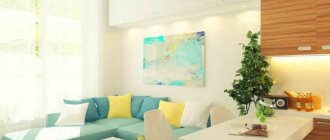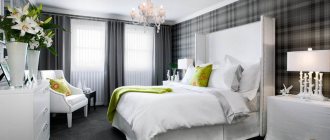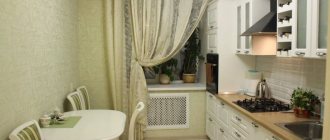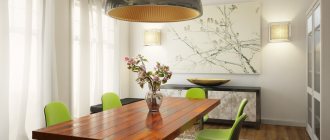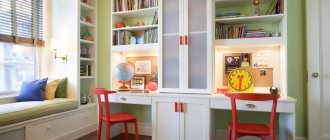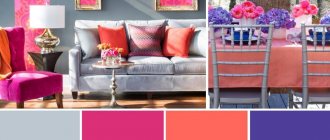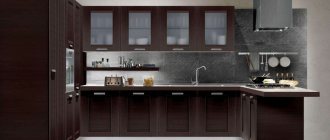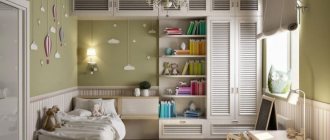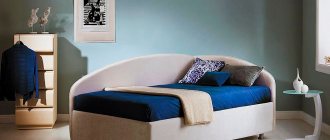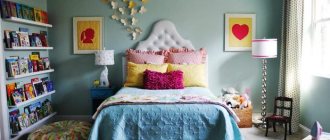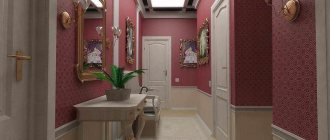You always want the best for children, which is why traditional ways of decorating children's rooms are beginning to fade into the background, giving way to more original and daring solutions.
Bright and positive interiors that can maintain a good mood and shape a child’s character are becoming increasingly .
It is no secret that the walls play a key role in this design, and the use of combined wallpaper for a nursery is considered one of the most convenient and simplest ways to create a positive environment.
Implementing your ideas with the help of bright or unusual combinations in a children's room will also be useful because it allows you to divide the space . This is very convenient, especially if your children share one room with each other.
Moreover, using this simple method, you can combine the interiors of boys and girls without depriving children of their personal space .
A wide range of wallpaper for children's rooms of different themes, colors and textures will allow you to turn any design ideas into reality, and with the help of our photos of combined wallpaper for children's rooms and practical tips, you can achieve the desired effect quickly and without extra effort.
The influence of color on a child's psyche
An error in the color design of a nursery will eventually affect the behavior of the owner of the room. If a child is attacked by unusual attacks of activity or apathy, it is difficult for him to fall asleep or concentrate on any task, it may be due to the wrong color scheme.
Therefore, it is important to take into account the characteristics of shades when choosing the main color for a children's room; psychology points to the following properties:
- Red. It not only invigorates and energizes, but also constantly keeps the nervous system in good shape. It is better not to get carried away with the color red, especially in a space intended for a baby. It can be used in doses and preferably not in decoration, but in accessories, otherwise whims are guaranteed.
- Orange. Also not among the leaders for decorating a nursery; its excess easily leads to overwork. Moderate use improves mood, so an accent wall, a couple of orange toys or an orange print on curtains (bed linens) won't go amiss.
- Yellow. It improves mood and has a positive effect on the intellect, but, like other bright colors, it is used as an additional color. The pale yellow version is good as a background tone, especially for shy children.
- Blue, blue. These colors, together with numerous shades, calm, relax, and relieve nervous tension. They can be safely used in the play area of a little fidget, but limited to young Pierrot’s room.
- Green. It subconsciously connects with nature, therefore it has a positive effect: it calms the nervous system, relaxes the eyes, improves memory. Light shades of green are refreshing, and therefore green is suitable for decorating a classroom.
- Purple, lilac. Bright, rich shades tire the psyche of a small child and distract attention. They cannot be made with primary colors; it is better to use the light version - light and pastel colors.
- Pink. In large quantities it affects the baby, just like purple. The recipe for use is the same.
For boy
Not only functionality and favorite colors should be present in the design of the room. It is very important that the interior also serves as a reflection of the teenager’s unique personality. Even if your preferences change every week (and this is exactly what happens in adolescence!), you can settle on something that will appeal to everyone over the next few years until the next renovation.
Psychologists believe that a correctly selected color palette helps in the development of personality: the potential of color therapy can hardly be overestimated, since everyone has colors that calm and others that irritate. You just need to identify them!
A young man’s room should have only all the essentials: a rationally organized workplace (perhaps not only a table, but also a small workbench or a place for working on technical issues), a bed, a wardrobe and a combination of a bookcase with shelves for all the most beautiful and necessary.
If your child loves Gothic and demands black walls and dark furniture, do not despair and invite him to read materials that explain in reasonable language that the color black has a depressing effect on the psyche, and a person may begin to develop depression.
But do not forget that a teenager is a maximalist who can stubbornly defend his point of view.
You will need to stock up on images of stylish designs in advance, in which only one wall or one corner of the room is given the opportunity to actively demonstrate the taste preferences of the occupant of the room. Other corners should be decorated in a different color.
If you and your child have a good, trusting relationship, it will not be difficult for you to explain to him that neutral wall colors make it possible to extremely diversify other decorative elements. The main thing is to decide on the theme and style!
Boy's room styles and colors
The main styles of modern decor that can be used when decorating a room for a teenager.
- Avant-garde, high-tech - the style of cool techies and computer scientists. Predominant primary colors: gray, steel, black, white, auxiliary colors (1 or 2) - lemon, red, mustard, sky.
- Country is a “rustic” style for household and household items. Predominant primary colors: brown, red, white, sand, secondary colors – green, beige, yellow.
- Safari, marine, genre. Any combination of colors is possible, but, as in other options, there should be no more than three primary colors.
- Kitsch and loft are the favorite styles of talented artists, musicians, and future architects. With this decision, it is customary to decorate with glossy surfaces and bright colors: scarlet, sea green, yellow, green, blue.
Temperament and color in a boy's room
As a rule, by adolescence, a child’s basic inclinations and needs have already been identified, and it is better to follow the recommendations of psychologists. They claim that choleric people prefer red and all its shades, sanguine people cannot do without glimpses of yellow and gold, melancholic people prefer blue, and phlegmatic people prefer green.
This is the “internal” palette of temperaments, while in practical life melancholic people most often choose warm tones, such as brown, orange or yellow, choleric people and sanguine people choose the coolness of blue, green, white, and so on with each type of temperament.
You need to make color blanks and decide what a teenager will enjoy looking at for a long time, and what will cause negativity.
You shouldn’t try to “re-educate” your temperament type to suit someone else’s preferences. Each of them is good in their own way, each has shortcomings, you can (and should!) live with all this, and live as comfortably as possible, and then everything will be fine!
Let the teenager draw room design options in a point or cockatiel, and you can adjust them together.
Color schemes for a teenage boy's room: photos
High-tech minimalism can be expressed in light gray walls. White can be used as the main color for furniture. For example, it could be a white bed frame with a dark gray mattress and colorful pillows, with black and white poster graphics above the bed.
Let there be a white cabinet, and to rest your eyes, place another one nearby - sand color or beige.
You shouldn’t be afraid of this color; the main thing is to select furniture with easy-to-clean surfaces. A white desk with multiple compartments for the computer, homework, and tech skills can take up an entire wall. A black and white striped carpet will complement the overall scheme and add a touch of mischief to the interior.
- A room in the “country” style consists of a cozy (possibly made in patchwork technique) blanket and carpet next to the bed, wooden furniture, preferably in natural colors, built-in wardrobes and shelves, comfortably decorated niches and window spaces.
- A sea or safari theme includes a wall-sized geographical map, an image of an active volcano, a “cave” bed and many other possibilities for imagination. Porthole windows, lifebuoys on the walls, flags and rope ladders - all this will allow the interior to look complete.
Anyone who likes to make technical models can easily decorate a room with them, and not only with them.
There may be photo curtains with airplanes on the windows, an exhibition of car models on the shelves, and photographs depicting any equipment that is of interest on the walls. The general background of the walls can be deep blue, sea green or beige, the furniture can be dark or light wood, depending on the wishes of the teenager. Lamps can be of original design. Alternatively, you can make the lampshades yourself.
Registration requirements
In the room where the child spends the majority of his time, it is necessary to provide:
- brightness of colors;
- positive mood;
- maximum heat;
- lots of natural light;
- good environment for relaxation and development.
This is possible if you combine and glue the wallpaper correctly. Combining their different types and designs is a very common solution. Now there are so many bright options with fancy patterns. But it seems that if you stick them all over the room, there will be a feeling of some overload. Use tips on combining bright and muted colors, large and small patterns, and make the children's room the best place for children to spend time.
We want to give our children all the best, because traditions fade into the background, we need to use bold, creative solutions. After all, it is from the nursery that the baby begins to learn about the world around him; here he will rest, study and work, laugh and cry, be sad, experience different emotions and keep his first childhood secrets. Brightness and a positive environment will form a good character in the child and also ensure a good mood.
The big advantage of combining is that it becomes possible to divide the space. This is convenient if you have two children, but they have one room for two. You can combine interiors for boys and girls, without each child being deprived of their own personal space.
For girl
Many parents approach planning a children's room very responsibly, because it is so important to take into account all the nuances at once, so that the child likes his new personal space and does not have to redo the room design or change the wallpaper later. Girls are especially meticulous about the choice of color and interior details. Little princesses always want to surround themselves with beautiful things, because the craving for beauty begins in childhood.
Therefore, to create a comfortable atmosphere in the nursery, you must first decide on the color scheme of the future room.
Spending time in this room every day, the child will absorb the mood of the color that will prevail in the children's room. Therefore, psychologists recommend decorating the interior of a children's room in light colors. They create harmony and comfort. They also visually expand the space and help make even a not very bright room more fun and cozy.
The color of the room must be selected individually based on the child’s color preferences and visual perception. It is not recommended to make a choice of wallpaper based on the principle: pink for girls and blue for boys. Combinations of several colors are quite suitable for a children's room.
So for little princesses, it is possible to choose different shades. For example, cold turquoise and warm beige or yellow.
And if a girl likes a certain color, then the task becomes much easier. It is taken as a basis and combined with adjacent colors or, for example, diluted with white so that the color is not too intrusive.
When choosing the color of the walls, do not forget that the room will also contain furniture, interior items and, as a rule, a lot of toys. Therefore, it is better to choose light and not very variegated shades for wallpaper. In a word, so that they do not have too many small and bright patterns.
The only exception is an accent wall, on which photo wallpaper or wallpaper with some kind of pattern is placed to enliven the room and visually expand the space.
For example, a wall with vertical stripes or a large repeating pattern. In this case, the remaining walls are painted in one color that matches the tone, or wallpaper without a pattern is glued.
Examples of nursery color schemes for girls
Fairytale-fantasy for gentle, dreamy and romantic young ladies. Such a room promotes the development of imagination. Suitable colors: pink, purple, blue, turquoise, mint, lilac.
- For active girls and nature lovers. Natural colors of foliage and trees are suitable for such a room. Such colors have a calming effect on the nervous system. They also awaken a desire to explore the world around us and a thirst for learning. Suitable colors: green, light green, brown, olive.
- Calm pastel colors. Suitable for any age. The biggest plus of these shades is their versatility. With age, children’s tastes often change, and if today the girls wanted to see butterflies on their wall, then tomorrow there will be princesses or flowers. Therefore, in order not to re-paste the wallpaper every year, it is better to give preference to pastel colors.
Such a room can be supplemented with paintings, accessories and curtains, which will slightly dilute the monotony and add dynamics. Suitable colors: beige, light gray, powder.
- Sunny yellow for a good mood. During the cold season, we all lack solar warmth and light. But they are so important for a positive attitude, especially for children. If there is also a lack of daylight in your nursery and the child periodically mopes due to cloudy weather, then dilute the room with bright yellow. To do this, add accents in the form of a carpet, curtains or furniture in sunny yellow tones. An accent wall or pattern with a similar shade would also be an excellent option.
It is not recommended to completely paint all the walls bright yellow or cover them with plain wallpaper, because then the room will be too colorful. Suitable colors: sand, yellow, lemon, orange.
When choosing colors for a children's room, first of all, you need to consult with your child. And offer several options to choose from, showing approximate photographs of the interiors.
Once the base color is chosen, it is important not to overdo it. After all, too much of one color in a nursery negatively affects the child’s development and puts pressure on the psyche. So it’s better to dilute it with white or choose colors that are not too bright and intrusive.
Materials
When combining wallpaper, you can experiment not only with colors, but also with different materials.
There are matte, glossy, velvety wallpapers. Among the most popular materials are:
Paper. A budget option is smooth single-layer wallpaper, but it is very difficult to work with. When water gets on the paper, they can tear easily. This is not very convenient when combining different parts. Due to the thin material, all defects will be visible on the wall.
The most suitable option is multi-layer duplex or triplex wallpaper. Their cost is slightly higher than the price of single-layer ones, but they also remain affordable for the average buyer. Such coatings hide minor imperfections on the walls. Their only drawback is that they quickly fade in the sun and tear easily.
If the walls in the bedroom are smooth, then you can glue silk-screen materials. They look very solemn. A slight shine will be noticeable even in the dark; it resembles the shine of natural silk fabrics.
A significant drawback of such wallpaper is the heavy air in the room. Due to the vinyl waterproof film, the walls practically do not breathe. However, the problem can be completely resolved if you regularly ventilate the room or install ventilation in it.
Non-woven fabrics are very durable, elastic and convenient for pasting walls. The technology is as simple as possible. A special glue is applied to dry wallpaper that does not corrode the surface. After this, the canvases are easily fixed on a vertical plane.
Such models are wide meter rolls. For large rooms this is very convenient; fewer joints are formed. It will be more difficult with small rooms. To avoid problems with joining the drawing, it is better to call a specialist who will minimize the likelihood of defects during the work.
Another disadvantage of non-woven wallpaper is its high price. However, it fully justifies itself due to the complex production technology and expensive fibers in the composition. By paying once, the apartment owner will not have to worry about the condition of the walls for many years.
Hard fibers from flax and jute are embodied in fabrics that resemble matting. Fleecy wallpaper is made of velor or felt. Woven fabrics are produced in the form of very wide rolls, using which you can cover one entire wall in one go. This is very convenient because you don’t have to join different edges.
When combining, choose textile wallpaper from the same material, but in different colors. For example, the silky base is presented in a wide spectral range. However, the combination of different parts will not be carried out on one wall, but throughout the entire space of the room.
Textile fabrics have two significant disadvantages - high cost and problematic maintenance. For example, velor surfaces accumulate a lot of dust, which is difficult to remove from the walls. Please note that wet cleaning is not suitable for textile wallpaper. For many, all these shortcomings are compensated by the aesthetic appeal of these coatings.
It is done in neutral (often pastel) colors. The ideal composition is when the background wallpaper is matched to the color of one of the details in the photo.
If the photographic canvas is placed above the sleeping place, then the furniture must be selected to match the tone of this wallpaper. Then the interior will look very harmonious and holistic.
For heterosexuals
To zone a room for two children of different sexes, it is best to use two primary colors in the interior. We are talking about pink and blue shades. This is a great option if the kids are small. After all, kids love everything bright.
Also, the design can be unusual, using various themes: jungle, fairy-tale characters, cartoons, animals, etc.
If this is a room for teenagers, then you can choose other colors. For example, wallpaper in purple-gray, pink-green, yellow-blue shades will look good. You can also use wallpaper in peach and apricot tones to decorate the walls. The color of sea green looks good in interior design, especially in combination with gray or khaki.
In addition, wallpaper of the right color can visually enlarge a small space. In this case, it is better to give preference to light colors in the design: beige, pastel, vanilla.
Remember that zoning a room with color is not just about choosing wallpaper. This is also a choice of furniture, carpets, textiles, and accessories.
Creating a panel
The use of an improvised decorative panel, for the creation of which expensive, luxurious designer wallpaper was taken, also allows you to create interesting decorative accents in the room. A living room with such an accent usually has a significant area, since the decor itself is usually made quite large.
Photo wallpapers with a 3D effect in a modern design bear little resemblance to landscapes with exotic palm trees and waterfalls. The technical capabilities of printing allow you to create pixel paintings in the style of computer games or adapt masterpieces of world painting to interior design. The imitation of forging, stucco, wood carving or stained glass looks interesting.
If a panel is used to decorate a TV area or a niche in which a false fireplace or columns are installed, deep, complex colors and matte textures are used here. When combined in this way, wallpapers with imitation of natural stone, bare concrete, and brick look interesting.
Combination of wallpaper of two colors in a nursery
Why do you need to combine wallpaper in a nursery?
We can name at least 5 reasons:
- To zone the space and visually divide, say, a shared bedroom of two children, into personal “territories.”
- The principle of zoning is also useful if the nursery has one owner. In this case, you can highlight a wall near the bed, a play or study corner in the room.
- By covering the walls with different wallpapers, you can divert attention from unsuccessful architectural solutions or change the visual proportions of the room.
- In order to make good use of leftover wallpaper.
- And just to make the nursery’s interior more interesting and fun.
In this material you will find 7 ways to combine wallpaper, 10 tips on how to combine coatings of different colors and types, as well as 30 photos of interiors for your inspiration.
Lyrical introduction or where the legs of a problem grow
First of all, I want to note that, judging by what I saw, combining wallpaper is actually a very popular technique in Izhevsk. And I think throughout the post-Soviet space things are exactly the same. I saved literally 80% of these photos because that's how many people use this method incorrectly. Something from the series: I saw this in “The Housing Question.” Then I looked at pictures on the Internet and did everything exactly the same. In fact, it’s far from exactly the same, and more often than not, quite the opposite.
I tried to figure out where the legs grow from. As usual, I googled the query “how to properly combine wallpaper with each other in one room” (judging by statistics, similar queries in different versions receive more than 10 thousand people monthly (!!!) and looked at the first five sites in the search results. It’s just that usually no one looks further And then a lot of things fell into place for me.
All articles were written by copywriters who are not at all interested in modern design and decoration, some sites of construction offices, repair companies. All the information is rotten and of little use, and at times downright harmful.
For example, on Homestar, the author claims that if there is an alternative - to cover a room with the same wallpaper or different ones, then designers advise choosing the latter...
Who are these designers? Where do they advise this? In fact, modern decoration allows for both. But in terms of the number of interiors, painted plain walls or plain wallpaper, rather than combinations, still lead by a large margin.
The biggest difficulty is to understand that the combination must pursue some goal, practically program a person, force him to look at the point you need, and not just so as not to be bored. This is not enough. If this is the goal, then it is almost guaranteed that it will turn out to be nonsense.
And now enough of the lyrics, it’s time to sort through the archive of photographs that I saved and show, using their example, typical types of wallpaper mix and the most common mistakes. Sit back, read, watch carefully and learn from the mistakes of others.
Combination methods
Method 1. Vertical combination
The technique involves decorating walls with alternating canvases of two colors/types or more. Vertical combination is good because it allows you not to join the pattern and not be “embarrassed” by the visibility of the seams. On the contrary, joints and vertical stripes will visually raise a low ceiling.
If you use more than two types of coatings, then you should select only one accent wall for this combination.
Rolls should be chosen with a width of no more than the standard 53 cm.
Below are photo examples of vertical wallpaper combinations in a children's room.
Method 2. Horizontal combination
This method is more traditional, since it resembles the classic decoration of the lower third of the walls with boiserie panels or lining, only instead of them there is the same wallpaper. The joints are most often covered with paper or any other borders.
However, the dividing line does not have to run in a straight line - perhaps it will be arcs, waves and even zigzags.
Keep in mind that combining canvases horizontally visually expands the room, but lowers the ceiling. This solution is also not suitable for highlighting an accent wall; using the described method you need to cover all the walls of the room.
How high should the bottom “tier” be? There are no strict rules here, but most often the sides are glued at a height of 1.10 cm from the floor.
At the bottom you need to glue wallpaper of a darker shade, and at the top - a lighter shade.
When using a border, you can combine wallpaper of different types, that is, of different densities and thicknesses. For example, you can stick a more practical vinyl underneath, then your baby’s graffiti can be washed off.
Method 3. Highlighting niches, ledges or accent walls
This technique involves the design of any niche, ledge, accent wall or its fragment. For this purpose, bright wallpaper, for example, photo wallpaper, is combined with plain coverings or with coverings with a calm pattern (polka dots, stripes, diamonds, checks, etc.) in a neutral color.
To zone a children's room, you need to highlight a wall near the bed, study table or play area.
By highlighting a niche, ledge or one wall with dark-colored wallpaper, and decorating the remaining surfaces in light colors, you can visually distance the wall, which means “enlarge” it a little and give depth to a small space.
Next, we present photo examples of zoning and highlighting an accent wall using wall decoration from two types of wallpaper.
Method 4. Creating a panel
In this case, bright and calm companions are also combined. The panels are limited by moldings or frames.
This decorative technique is an excellent reason to use leftover wallpaper.
Method 5. Decorating not only the walls, but also the ceiling
Companion wallpaper can be used not only to decorate walls, but also the ceiling. In this case, the child will be able to look at interesting pictures on it before going to bed.
For a small and low children's room, finishing the ceiling and walls with wallpaper is only available with light wallpaper.
Method 6. Patchwork style combination
Zoning a room or highlighting an accent wall can also be created using a combination of pieces of wallpaper of different colors, types and sizes using the patchwork technique. Since the “patchwork” wall turns out to be variegated, the second companion should be monochromatic.
A patchwork wall looks great in a country style, shabby chic, bohemian and Scandinavian interior.
Method 7. Creating “optical illusions”
By decorating the walls with wallpaper of different colors, you can change the proportions of the room. So, in order to expand a narrow and long room, you need to cover the ends with light canvases, and the long walls with darker ones.
And, conversely, you can add intimacy to a spacious room by covering the ends with darker coatings, and the long walls with lighter ones.
Wallpaper design for the hall: combined variations
The fashion for wallpaper in different colors for one room continues. Today it has reached its peak, as it allows you to create amazing interiors in the hall and other rooms. For example, you can paste a plain canvas on three walls, and decorate the fourth surface with patterns or other catchy prints to give the room character. Combined wallpaper for the hall can be anything you want, it all depends on personal tastes and preferences.
Wallpaper with stripes
Stripes in various color combinations are associated with Mediterranean, maritime, and also English style. Horizontal or vertical lines give the space a special climate, distinguishing it from other interiors. It's always a pleasure to be in such a design. Don't forget that horizontal stripes visually make the room taller.
Pop art wallpaper
Modern, colorful, fresh hall for young, creative people. In the living room, very original wallpaper is used on one wall, and the others are covered in soothing colors so that there is no chaos in the room. In addition, a striking interior style in a bright and eye-catching palette will go well with dark brown wooden floors. Overall it is an energetic design with a distinctive, strong color accent.
Glitter Wallpaper
An eclectic and brilliant decor for a bright living room can be created with shimmering wallpaper. Cover the walls with shimmering canvases with richly decorated designs. The original pattern guarantees each space a unique design. This type of wallpaper in the living room will look beautiful in the presence of stylish furniture, which will not distract from the extravagant design and will serve as the basis for a unique interior. Thanks to this, the space will look luxurious and expressive.
Wallpaper in Indian style
A beautiful Indian style living room wallpaper design will not disappoint you. This theme in interior design is characterized by richly decorated accessories, be it wallpaper on the wall or cushions on the chairs. One wall can be decorated in a charming paisley pattern, while the other can be a solid color in a harmonious color. The entire living space presents a unique picture.
Black and white wallpaper
An original, distinctive interior that catches everyone's eye with an exclusive appearance and many intricate patterns is the black and white combination of wall paintings. The style of the room is difficult to define because it is partly eclectic but with a touch of glamour. This design solution is suitable for experimenters who are not afraid to express their individuality.
Colorful wallpaper
Colorful, lively wallpaper for the hall will fill the room with strong and expressive colors. To arrange this type of living space, you must first consider whether this amount of color will strain the eyes. Follow current trends to create a stylish and original living space in the hall. When combining wallpaper, use wall canvases with a 3D pattern.
Wallpaper in pastel colors
A safe combination of elegant colors for a timeless combination. These types of interiors are distinguished by the fact that they will be fashionable even in 5 and 10 years. The classic combination guarantees a modern and neat space for years to come. Wallpaper in soft colors gives the room a special sophistication.
The combination of blue color in the interior of a nursery
Thanks to different color combinations, cool blues and light blues can become softer and more expressive.
Blue-pink children's
Such a duet looks bright and harmonious. The combination of blue and pink suggests the creation of a very stylish, calm and romantic design with a touch of romance.
Children's room in blue and white colors
The blue and white palette is considered a classic choice for a boy's room. This contrast does not cause irritable emotions or eye fatigue. With its help, you can visually expand the space and create a light and airy atmosphere in it.
An interesting effect is obtained by combining white walls with turquoise patterns or using furniture in white and blue tones.
Brown and blue children's room
Sky blue shades, diluted with elements of brown, will give the environment a feeling of warmth and coziness. Blue is used to decorate walls, white is preferred for ceilings, and flooring and furniture are chosen in brown tones.
Blue and orange room
Taking into account the coldness of blue and cyan shades, orange colors are used to soften the atmosphere and fill the space with the warmth of the sun. Such design does not hide the area of the room and does not deprive it of freshness.
Beige-blue
Beige walls give the room layout greater clarity. Refined and sophisticated beige is favorably emphasized by blue furniture and decorative elements.
Children's room in green and blue tones
The green-blue combination is as natural as possible. With the addition of light green shades, the atmosphere is brightened and will stimulate positive emotions, which will help lift your mood.
Yellow and blue interior
This color combination is a bold, experimental and energetic solution. Cool blues and warm yellows create a balanced balance and are perfect for a growing child's bedroom.
In a baby's nursery, the blue-yellow palette is used fragmentarily as accents.
Shades of color
To create a calm and almost ephemeral atmosphere in a room, soft blue pastel colors are perfect. Pale colors in the interior look isolated and elegant, which gives the space a special sensitivity.
You can give the atmosphere a summer mood with the help of azure shades.
The design of a room in dark blue helps overly active children tune in to the learning process, promotes control of emotions, feelings and rational thinking.
The combination of pink color in the interior of a nursery
Paying tribute to the designers, it is worth noting that dullness and routine are becoming a thing of the distant past, giving way to bright and original solutions. Today's life is filled with colors and comfortable details, while remaining quite spacious and functional.
A good example is the pink children's room.
It is clear that such a design is typical for a girl’s abode, since this glamor does not suit boys at all. Using a palette of these tones, you can create a cozy atmosphere for a girl of any age by choosing a style that suits your spirit.
A pink nursery is the dream of most girls. This color creates a magical atmosphere.
Pink is a complex color, classically made up of red with a dash of white, but it can also have purple, blue or orange notes.
Psychologists believe that the color pink has a good effect on the child’s psyche - it does not excite or cause aggression, but this only applies to pastel colors. Rich pink is difficult to perceive, but it can be used in details without overloading the interior.
For designers, pink is an ideal color, it goes well with many shades, and on its basis you can create different design styles.
To decorate a nursery in pink, you can use the following colors:
- White. The combination of white and pink will add sophistication, solemnity and tenderness to the room. For example, the walls and bedding can be decorated in soft pink, and the furniture in the nursery can be made white.
- Grey. It will balance the main color and add a feeling of peace and stability.
- Yellow. Will add positivity and energy. Bright yellow interior elements will help drive away drowsiness and add vigor and activity.
- Green. A classic combination given by nature itself: a pink flower on a green stem. The combination of these colors will be harmonious and beautiful.
- Blue. A peculiar combination. However, the right shades will help create a stylish room. At the same time, it is better to use it for decorating children's rooms in a modern style.
- Brown. Pink and brown are contrasting colors, but their combination is gentle and harmonious. A pink children's room with brown accents will appeal to a girl, since these neutral colors for decoration can be diluted with bright elements.
When designing colors, it is important to choose colors from the same palette - warm or cold. For a room facing north, decorating with warm colors is more suitable, while for the sunny side you can use a cool range of shades.
If the room is small, it is better not to use bright pink on the walls and furniture, as this will visually make the room smaller and make the furniture larger. However, it can be used for contrast, for example, making one wall bright and the rest light, this will visually add volume.
Color combination with turquoise in the nursery
The versatility and diversity of the color spectrum make turquoise a universal way to decorate a child’s room, thanks to which you can design an interior with a perspective, “for growth.”
The play of colors with bright details and proper lighting allows you to create a cozy and harmonious atmosphere.
Many associate it with water themes. And not in vain. After all, the resulting design conveys a feeling of freshness and vigor, like during a sea breeze.
How to choose shades?
As the main background, it is better to use a light and neutral palette (pale, with a blue tint or aquamarine). Bright and rich colors (dark turquoise, pearl) will be needed to decorate one of the walls (accent) or as decorative elements.
Light turquoise children's wallpaper will help visually increase the space. And richer and deeper colors will refresh sunny rooms.
Don't be afraid to improvise and give up monochrome! A turquoise nursery will only benefit from having an accent wall! Feel free to use stripes and prints (within the same spectrum or contrasting solutions).
This way the child’s room will acquire taste and personality.
The choice of colors largely depends on the child’s temperament.
Mischievous and restless children need restrained shades with a green undertone (for example, light green or sea green). And for quiet people, more intense, cheerful options paired with bright details are suitable.
Textiles can contrast with the main background or be within the same spectrum. If you don’t want to take risks, then opt for white weightless curtains. Plain or patterned - it doesn’t matter, the main thing is not to overload the situation.
But if neutral-colored walls and bright details are necessary, then feel free to hang turquoise curtains in the nursery.
It is better to use wooden texture as a floor covering. This will add comfort and harmony. Don't forget about carpets. The color scheme can contain all the shades used in the interior or be monophonic.
Variety of choices
Children's wallpaper can be purchased ready-made or made to order. The following are chosen as a source of inspiration:
- Famous landscapes of Shishkin, Levitan, Kuindzhi or their collages,
- Wrappers from famous candies - “Bear in the North”, “Mask”, etc.,
- Heroes of fairy tales and cartoons - Spider-Man, Harry Potter, etc.,
- Children’s favorite places and means of transportation are mountains and waterfalls, bicycles and hot air balloons,
- Unusual textures - plush, felt, cobblestones, drops on glass).
Photo wallpapers depicting dolphins in the water, a fountain with splashes, seagulls soaring in the sky or pink flamingos look impressive and evoke wonderful dreams of distant countries and travel.
Combination with other colors
Monotony in the interior is boring and difficult to perceive. So don't be afraid to add some color to your home.
Competent color combinations create the necessary effects and set the overall mood.
Let's look at the most successful combinations.
- A white turquoise children's room is a classic and win-win option.
It is fresh, light and cheerful. This is an excellent solution for small spaces. Such an environment will stimulate the child to be creative, learn and achieve new results.
- Turquoise gray children's is universal.
Any child will live comfortably in it, regardless of age and gender. Gray reveals all the beauty and depth of turquoise. Therefore, interiors in this combination are especially expressive and interesting.
- Turquoise pink children's room is specially created for gentle natures.
Of course, this is a girl’s space. Pink adds warmth and softness to a room. A feeling of peace and tranquility is created. The main thing is to choose the right color scheme. The blue undertone of turquoise is best combined with a reddish tint, and the green undertone with peach.
- The turquoise yellow nursery is bright and cheerful.
The main thing is not to overdo it with saturation. Opt for muted and calm shades. It is better if turquoise dominates. Combinations with orange colors are also selected.
A beige turquoise children's room envelops you with its warmth and tenderness.
This is an excellent solution for a baby's room or a sophisticated person. You can achieve balance if you use beige as a dominant color. There can be many variations: from delicate cream to brown. A bright spot will be turquoise children's furniture and decor.
- Turquoise-violet children's room is designed for creative and extraordinary individuals.
Deep colors are more suitable for teenagers. And soft pastel colors will create a gentle and romantic atmosphere. Combine and alternate them when decorating walls and decor - this will create the necessary balance.
As you can see, decorating a nursery in turquoise is quite simple.
You just need to think through the general scenario in advance and show a little imagination.
Especially the principles of design
Since the room is intended for children, you can show all your imagination in it and follow several directions at once, making maximum use of the designers’ non-standard ideas. However, if you have not had to deal with such tasks before, then the whole process of combining may not be easy. In this case, it is recommended to contact professional specialists.
To ensure that there are as few problems as possible when combining, you should buy all the wallpaper for work in one place in order to immediately assess the entire integrity of the future picture. In this case, you will have the opportunity to put the wallpapers next to each other and understand how they fit together.
Combination of colors in children's furniture
As for furniture, it is better to choose neutral shades for the children's bedroom. This way, even if you want to renovate and repaint the room, you won’t have to change the furniture.
The best option is the color of natural wood. If the bedroom is made in warm shades, then it can be yellowish-brown wood, sunny and warm, with a beautiful varnished surface. Light sand, soft beige or even white furniture is suitable for almost any interior.
You should not choose dark furniture, it will weigh down the interior. Choose furniture in the same color scheme, so there will be a feeling of a harmonious and stylish ensemble.
Wallpaper color combination in a children's room
As an original option for decorating walls in a children's bedroom, you can consider decorating the wall with wallpaper in two colors. For example, interior professionals consider a combination of light blue and light yellow colors to be successful.
To “dilute” the monotony of the canvases, you can choose trellises that have small inclusions of a different color. Getting rid of the monotony of paint allows you to get an excellent result that will be positively perceived by the child.
It is important to choose a certain shade, taking into account the gender of the child. For example, for a room girls use warm colors and pink shades. Boys need rooms decorated in "cool" color combinations.
In their “domains” blue and blue tones, complemented by gray and beige colors, will be appropriate.
Pastel shades chosen for decorating the walls in a room can bring harmony and comfort to the room. They will not make the room too “grown-up”; they will leave the child his own cozy corner.
The delicate shades of pink wallpaper will lull and soothe a newborn baby.
If desired, you can use a variety of bright designs to decorate the walls in the children's room. For example, voluminous stickers with butterflies, funny animals, and flowers will help develop the creative imagination of schoolchildren and develop their interest in research.
As an additional detail, professionals suggest using toys in contrasting colors. They will attract the attention of children and become the object of their first studies and observations.
But when choosing bright colors, it is important to observe moderation. Otherwise, there is a high risk that the room will become too “spotty”, and the materials chosen for its decoration will become serious irritants for children.
What else do psychologists recommend that moms and dads who decide to make changes to the appearance of their baby’s room take into account? Experts advise taking into account the type of temperament of the owner of the room. For example, if the baby is a cheerful choleric person, muted shades would be appropriate in his room.
For example, for such a fidget, you can choose trellises in cool blue shades, which will “seat” the fidget for lessons.
Attention! A huge number of bright toys in the room of a sanguine or choleric person can increase their activity, and dealing with such a mischievous person will be very problematic.
A little phlegmatic or melancholic person simply needs bright details in the created interior. For example, you can highlight a small accent in the form of a red panel, so that “such a spot” stimulates the child to be active.
Photos of various examples of flowers in the interior of a nursery
Photographs of children's interiors will help you get inspired and filled with ideas. Look how many wonderful options the designers have come up with!
Take the issue seriously, combine shades harmoniously and do not forget that color affects the psyche and mood of your baby. And let his room be the most comfortable and beautiful!
